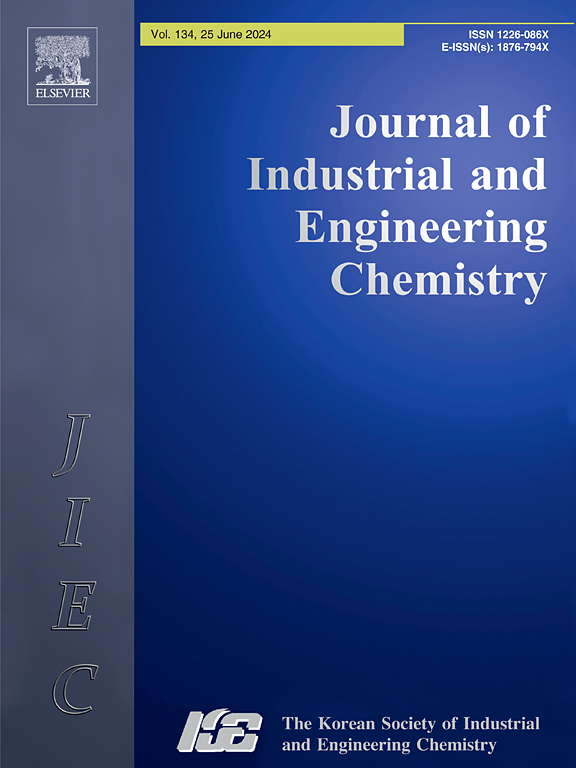磁性可分离氧化铁纳米颗粒在水介质中还原硝基芳烃和羰基化合物的还原性胺化
IF 5.9
3区 工程技术
Q1 CHEMISTRY, MULTIDISCIPLINARY
Journal of Industrial and Engineering Chemistry
Pub Date : 2024-11-26
DOI:10.1016/j.jiec.2024.11.034
引用次数: 0
摘要
使用 Adiantum capillus-veneris 提取物(aq.)作为封盖剂和稳定剂合成了新型生物氧化铁纳米粒子(Fe@BNPs),并使用傅立叶变换红外光谱、紫外可见光谱、外表面可见光、电离辐射X、电子显微镜、XPS 和 XRD 技术对其进行了细致的表征。随后,Fe@BNPs 被用于在水中良性反应条件下利用水合肼催化还原各种硝基芳香族化合物。值得注意的是,Fe@BNPs 的磁性使其能够利用外部磁铁轻松回收,从而促进了催化剂在多个循环中的重复使用,并将沥滤或活性损失降至最低。此外,Fe@BNPs 在还原胺化反应中的应用(采用硝基还原伯胺和羰基化合物)也证明了它的多功能性。这种不含配体的方法具有显著的优势,包括环境可持续性、绿色溶剂、优异的产品收率、简单的工作程序、高效的纯化、克级反应和出色的催化剂重复使用性。本文章由计算机程序翻译,如有差异,请以英文原文为准。

Magnetically separable iron oxide nanoparticle for reduction of nitroarenes and reductive amination of carbonyl compounds in aqueous medium
Novel biogenic iron oxide nanoparticles (Fe@BNPs) were synthesised using Adiantum capillus-veneris extract (aq.) as a capping and stabilising agent and meticulously characterized using FT-IR, UV–vis, FESEM, EDX, TEM, XPS, and XRD techniques. Subsequently, Fe@BNPs were employed for the catalytic reduction of various nitroaromatic compounds employing hydrazine hydrate under benign reaction conditions in water. Notably, the magnetic behaviour of Fe@BNPs enabled their facile recovery using an external magnet, facilitating catalyst reuse in multiple cycles with minimal leaching or loss of activity. Furthermore, the versatility of Fe@BNPs was demonstrated through their application in reductive amination reactions, employing nitro-reduced primary amines and carbonyl compounds. This ligand-free approach offers significant advantages including environmental sustainability, green solvent, exceptional product yields, straightforward workup procedures, efficient purification, gram-scale reactions and excellent catalyst reusability.
求助全文
通过发布文献求助,成功后即可免费获取论文全文。
去求助
来源期刊
CiteScore
10.40
自引率
6.60%
发文量
639
审稿时长
29 days
期刊介绍:
Journal of Industrial and Engineering Chemistry is published monthly in English by the Korean Society of Industrial and Engineering Chemistry. JIEC brings together multidisciplinary interests in one journal and is to disseminate information on all aspects of research and development in industrial and engineering chemistry. Contributions in the form of research articles, short communications, notes and reviews are considered for publication. The editors welcome original contributions that have not been and are not to be published elsewhere. Instruction to authors and a manuscript submissions form are printed at the end of each issue. Bulk reprints of individual articles can be ordered. This publication is partially supported by Korea Research Foundation and the Korean Federation of Science and Technology Societies.

 求助内容:
求助内容: 应助结果提醒方式:
应助结果提醒方式:


